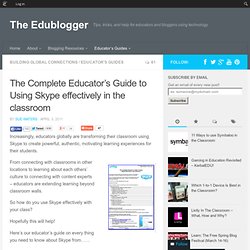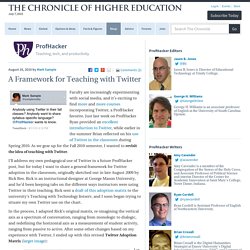

Blogs. You've seen the word, you've seen the web sites and you may even have one.

But have you ever wondered: What's the big deal about blogs? To make sense of blogs, you have to think about the news and who makes it. We'll look at news in the 20th vs. the 21st century to make our point. In the 20th century, the news was produced professionally. When news happened, reporters wrote the stories and a tiny group of people decided what appeared in a newspaper or broadcast. The 21st century marked the point where news became both professional and personal. As blogs became popular, they created millions of news sources and gave everyone an audience for their own version of news. QR Codes: Applications in Education. 30+1 Ways You Should Be Using Facebook in Your Classroom « Magic in education!
The Complete Educator’s Guide to Using Skype effectively in the classroom. Increasingly, educators globally are transforming their classroom using Skype to create powerful, authentic, motivating learning experiences for their students.

From connecting with classrooms in other locations to learning about each others’ culture to connecting with content experts – educators are extending learning beyond classroom walls. So how do you use Skype effectively with your class? Hopefully this will help! Here’s our educator’s guide on every thing you need to know about Skype from…… 1. Setting up your account A. 2. A. 3. A. Alternatively, here’s The Complete Educator’s Guide to Using Skype effectively in the classroom PDF version — for you to download and print off. About Skype Skype is a free application that allows you to call people from all over the world using the Internet. When you contact another person that uses Skype you talk or chat for free. Best of all you can tell when another user is online and what their status is so you know if they are available. A. 1. 4. B. 1. A Framework for Teaching with Twitter. Faculty are increasingly experimenting with social media, and it’s exciting to find more and more courses incorporating Twitter, a ProfHacker favorite.

Just last week on ProfHacker Ryan provided an excellent introduction to Twitter, while earlier in the summer Brian reflected on his use of Twitter in the classroom during Spring 2010. As we gear up for the Fall 2010 semester, I wanted to revisit the idea of teaching with Twitter. I’ll address my own pedagogical use of Twitter in a future ProfHacker post, but for today I want to share a general framework for Twitter adoption in the classroom, originally sketched out in late August 2009 by Rick Reo. Rick is an instructional designer at George Mason University, and he’d been keeping tabs on the different ways instructors were using Twitter in their teaching. Rick sent a draft of this adoption matrix to the university’s Teaching with Technology listserv, and I soon began trying to situate my own Twitter use on the chart. How to Use Google Search More Effectively [INFOGRAPHIC]
Among certain circles (my family, some of my coworkers, etc.)
![How to Use Google Search More Effectively [INFOGRAPHIC]](http://cdn.pearltrees.com/s/pic/th/google-effectively-infographic-127984952)
I'm known for my Googling skills. I can find anything, anywhere, in no time flat. My Google-fu is a helpful skill, but not one that's shrouded in too much mystery — I've just mastered some very helpful search tricks and shortcuts and learned to quickly identify the best info in a list of results. Sadly, though web searches have become and integral part of the academic research landscape, the art of the Google search is an increasingly lost one. A recent study at Illinois Wesleyan University found that fewer than 25% of students could perform a "reasonably well-executed search. " That search process also included determining when to rely on Google and when to utilize scholarly databases, but on a fundamental level, it appears that many people just don't understand how to best find the information they seek using Google.
Thanks to the folks at HackCollege, a number of my "secrets" are out. Infographic via HackCollege. Using Social Networking to Build 21st Century Skills - Finding Common Ground. "Good people know that high stakes testing has limited value and they keep operating anyway.

They don't let testing get in the way of doing the good work they want to do to get kids prepared for life. " Todd Whitaker In education we have a habit of using terms so often that we push staff to a place where they do not want to use them anymore, which means they are in jeopardy of not being engaged in the process. We have seen it with terms such as "differentiated instruction" and "hands-on learning. " If we're not careful it will happen with a very important term which is "21st century skills. " The tendency to dislike a term after it is used too often happens because many educators are concerned that it's merely a new twist on an old idea. The race to nowhere is paved in countless mandates and new ideas. However, are they really new ideas? In addition, one of the best 21st century skills that we can teach students is the art of reflection.